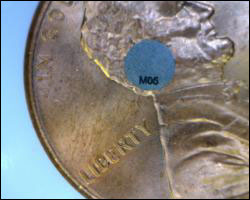
Potomac Photonics, UMichigan Partner on Laser Micromarking
LANHAM, Md., April 12, 2013 — Potomac Photonics has completed a micromarking project for the University of Michigan in Ann Arbor that supports research on how extreme conditions in nuclear power reactors affect various metal alloys.
Micromarking is becoming more prevalent in a variety of applications, including serialization of microdevices, covert identification and counterfeit detection. To determine the appropriate laser micromarking solution, part, material and mark-size requirements must be considered.
The UMichigan study focuses on how higher levels of radiation and extreme temperatures commonly encountered in new reactor types affect the shape, hardness, ductility and susceptibility to cracking of the materials.
 To track the 100 samples of the eight types of alloys being tested, each will be assigned a 3-digit code as it is placed in the high-flux nuclear reactor. The code, with a maximum height of 250 µm, is marked on parts only 3 mm in diameter and 250 µm thick. The markings will help identify each sample and effectively trace the conditions and experiments to which it was exposed.
To track the 100 samples of the eight types of alloys being tested, each will be assigned a 3-digit code as it is placed in the high-flux nuclear reactor. The code, with a maximum height of 250 µm, is marked on parts only 3 mm in diameter and 250 µm thick. The markings will help identify each sample and effectively trace the conditions and experiments to which it was exposed.
“Postexposure, the samples will be tested using several different experimental techniques,” said Tyler Moss of the university’s nuclear engineering and radiological sciences department. “Their mechanical properties will be measured by shear punch and hardness indentation. So, the surfaces of the samples need to be free of any defects. The structure and chemistry of the material will be measured by electron microscopy and atom probe tomography.”
The primary challenge, Potomac engineer John Ford said, was to come up with a way to accurately handle and position such small parts.
With only a two-week window to complete the project, Potomac Photonics designed and built a custom fixture capable of holding the miniature samples so that they could be marked quickly and in very precise locations. In addition, the process was developed so that each of the markings could be read at a minimal magnification level of 15X.
For more information, visit: www.potomac-laser.com
/Buyers_Guide/Potomac_Photonics_Inc/c12038